When was the last time you enjoyed beaches and their shoreline palm tree? You must have cherished your stay in the Maldives or any tropical shores if you had a chance to experience it.
Unfortunately, not everybody can enjoy the view of such amazing palm trees and breezy vibes.
Don’t worry!
We have indoor palm trees that can help you recreate them for yourself!
Bonus: you also get to breathe in the fresh air. That’s right, cleanse your respiratory system from the toxic urban gasses by growing these amazing air purifiers.
Read on, as we have collected an impressive list of 20 different types of indoor palm plants. We are also sharing some fab tips to
List of 20 different types of indoor palm plants
| S.No | Name | Image | Description |
| 1. | Majestic Palm | Are you ready to invite the tropical vibe into your living room? Plant these mighty feathery leafed Palm trees indoors and instantly enjoy the visual freshness! As a bonus, you can all breathe healthier with their air-purifying properties. | |
| 2. | Areca Palm | The Areca Palm tree can be a great choice if you believe in luck. These perennial air purifiers are famous for their good vibes and add tropical freshness to you indoors! | |
| 3. | Ponytail Palm | Get yourself a NASA-approved natural air purifier! These are the best air purifiers among the other different types of indoor palm plants. They absorb the toxic gasses and emit fresh oxygen. These plant’s attractive long slender leaves are also aesthetically appealing and refreshing. | |
| 4. | Parlor Palm | Cramped space will no longer be an issue with these parlor palms! They are slow growers and take several years for a 1-foot tall plant to reach 2 feet. Placing them in bright, indirect sunlight can help them boost plant growth. | |
| 5. | Cascade Palm | These palms with long slender stalks and large green fronds can be a great style element in your interior spaces. They are also called cataract palms or cat palms. They are slow-growing and can perfectly be grown in pots. | |
| 6. | Sago Palm | These are easy to grow indoor palm trees and work great for ornamentations. The stiff spine-like fronds adda great texture and tropical freshness for your indoors. | |
| 7. | Fishtail Palm | These plants have long stalks with leaves branching at alternative nodes. They have fishtail-like leaf blades and claim the name ‘Fishtail Palm’. They are easy to grow and tolerate shade. | |
| 8. | Kentia Palm | Growing palm trees can’t get any easier with Kentia Palms! They are the most adaptable and easy-growing variety you can ever own! It is perfect for those with little to no time to maintain their plants yet who love to grow one. | |
| 9. | Chinese Fan Palm | Looking for a versatile palm tree to upgrade your living room? These Chinese fan palm trees have very distinctive fan-shaped, feathery emerald green fronds, setting them apart from the other different types of indoor palm plants. | |
| 10. | Pygmy Date Palm | A perfect ornamental plant that fits your room proportionally! The leaflets also arch relatively less and take much less space to grow. These are easy to grow plants and require moderate sunlight and watering. | |
| 11. | Yucca palm | Choose the right variety to grow as a houseplant. Pick the appropriate variety of Yucca as the Yucca aloifolia, a sibling of the Yucca species, have razor-sharp spines compared to the feathery fronds of Yucca elephantipes. | |
| 12. | European Fan Palm | These palms add a unique touch to your indoors, with the plant’s fan growing upward. Unlike the regular fronds, these plants have fronds spread in a circle of 300 degrees. | |
| 13. | Ruffled Fan Palm | If fan palms are your favourite, ruffled palms will be your favourite! They have a gorgeously pleated fan-like frond And look great when grown indoors. These pleats also add an amazing texture to your interiors. | |
| 14. | Bamboo Palm | If you are an absent-minded person who often forgets to water, you better skip this plant! They are tropical plants that need lots of moisture and humid conditions to thrive. They look great as a decorative element in your courtyard or as a space divider. | |
| 15. | Lady Palm | These palms can comfortably stay in the window corner of your room and accompany you for ages! They are famous for their slender brown stem’s dark green fan-shaped leaves. They are also a great air purifier! | |
| 16. | Sentry Palm | A great plant to add an accent to your hallways and entrance! These are often used at the entrance of hotels and malls to create an inviting vibe to the place. The extra arching fronds become a natural visual focusing element. | |
| 17. | Christmas Palm | Before you ask, No Christmas Palms are different from the Christmas tree. Looks great when you plant them in clusters of 2 or 3 plants near one another. | |
| 18. | Lipstick Palm | Looking for some colour? How about the vibrant tree that matches your lipstick shade? It’s incredible how versatile these plants can be. They have bright red stalks gradually tapering into green fronds. | |
| 19. | Red Feather Palm | If you love red, you will love this plant! It’s ridiculous how fabulous the fronds look with a red tint; they are simply magnificent! | |
| 20. | Diamond Palm | Some more fans? Well, these plants are fully into fans, so much that they don’t have any visual stem shooting above the soil. They have widespread fans and suits better in big hallways than in bedrooms! |
Let’s discuss each palm plant briefly,
1. Majestic Palm

Botanical name: Ravenea rivularis
These robust tropical plants need moderate water, sunlight and humidity. They are slow growers, so you can stop worrying about these plants overgrowing your interiors. Refrain from placing the plant in bright sunlight to avoid burning the delicate leaves.
| Height | 10 feet |
|---|---|
| Lifespan | 40 years |
| Sunlight | Bright to indirect light |
2. Areca Palm

Botanical name: Dypsis lutescens
These Palm trees grow well in bright sunlight, high humidity and moderate watering conditions. The key to promoting growth is abundant sunlight, though avoid burning the leaves by placing them in direct sunlight.
| Height | 2 – 6 feet |
|---|---|
| Lifespan | 10 years |
| Sunlight | Bright indirect sunlight |
3. Ponytail Palm
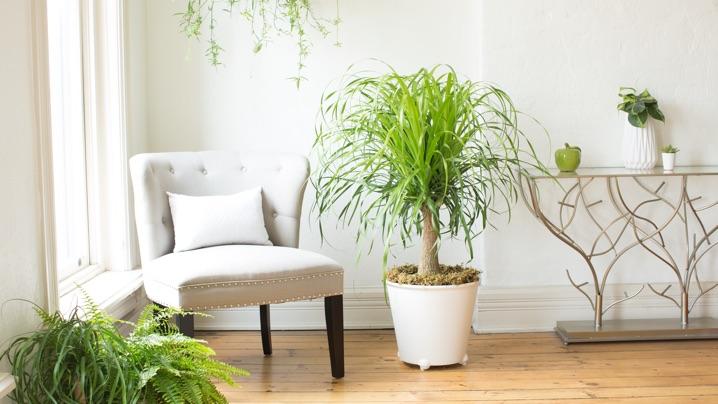
Botanical name: Beaucarnea recurvata
These slow-growing palm trees need lots of sunlight and moderate watering. These plants have swollen roots and can stay unwatered for up to 4 weeks. Check the 2 inches of topsoil, and wait for it to dry before the next watering.
| Height | 4 feet |
|---|---|
| Lifespan | Several decades |
| Sunlight | 6-8 hours of indirect sunlight |
4. Parlor Palm
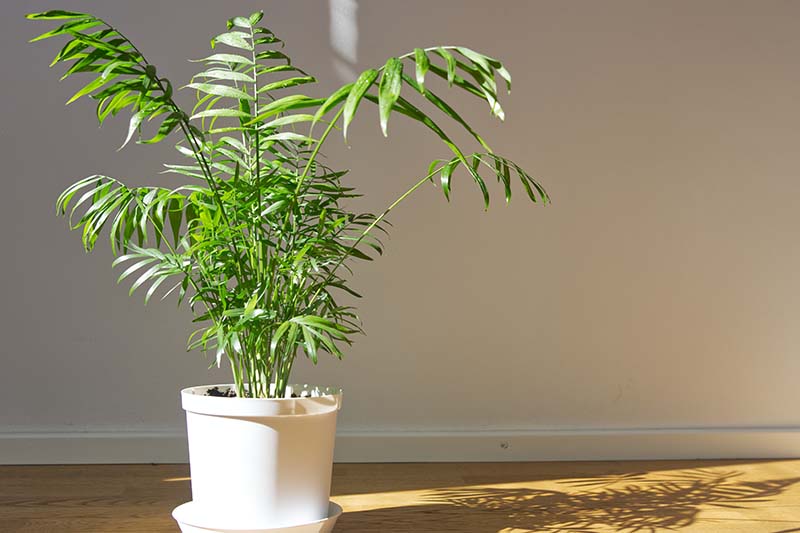
Botanical name: Chamaedorea Elegans
These plants tolerate low light conditions and hate water clogging. As they mostly stay in common lit areas, the evaporation of excess water from the planter pot is minimal. It’s better to wait until a few inches of the topsoil to dry before watering them again.
| Height | 2 – 6 feet |
|---|---|
| Lifespan | 40 years |
| Sunlight | Bright and indirect sunlight |
5. Cascade Palm

Botanical name: Chamaedorea cataractarum
These palm trees like moist and well-draining soil. They thrive best in bright indirect sunlight though they can also tolerate partial shade. Water then regularly for once or twice a week depending on its sun exposure.
| Height | 3 feet |
|---|---|
| Lifespan | 10 years |
| Sunlight | Bright and indirect sunlight |
6. Sago Palm
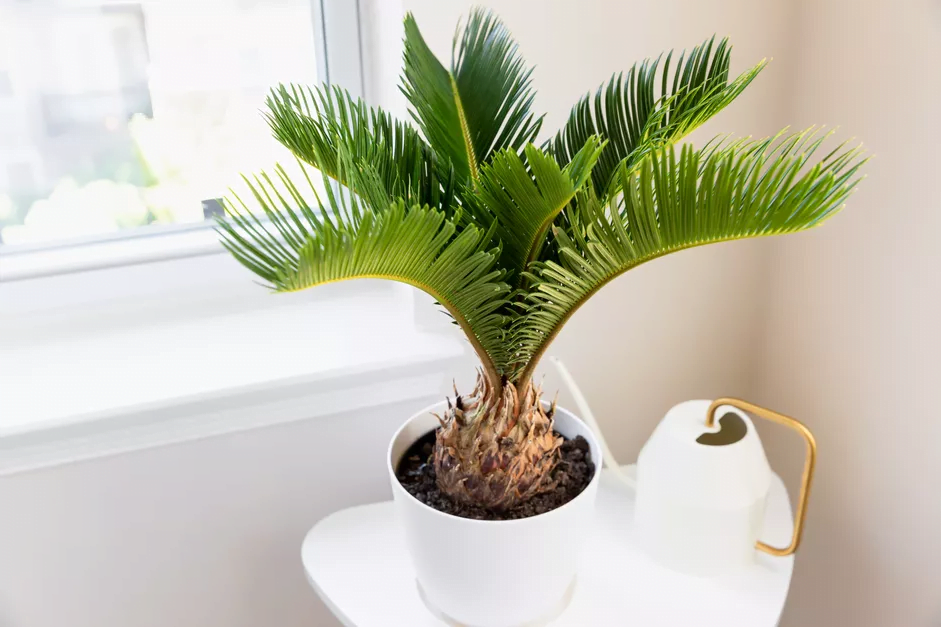
Botanical name: Cycas revoluta
These simple trunked plants with feathery fronds that are stiff have spine-like tips. They are slow growers and take 5 or more years to reach their maximum indoor height of 2 feet. They are drought-tolerant plants, so avoid overwatering them.
| Height | 2 feet |
|---|---|
| Lifespan | Over 100 years |
| Sunlight | Bright indirect light, though it can also tolerate shade |
7. Fishtail Palm
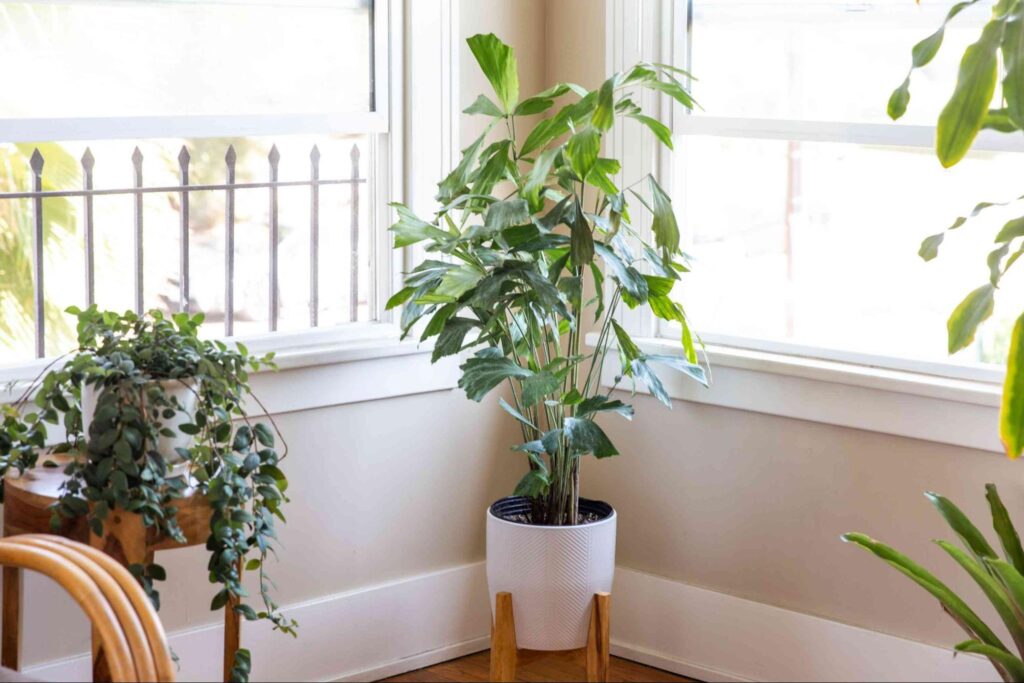
Botanical name: Caryota
Want to add an exotic look to your indoors? Try out these fishtail palm plants as they are aesthetically appealing and thrive in low light conditions. So good that you can easily grow them in your bathroom or laundry room! Provided you maintain a minimum temperature of 10 degrees Celsius
| Height | 8 feet |
|---|---|
| Lifespan | 25 – 30 years |
| Sunlight | Bright indirect light, though it can also tolerate shade |
8. Kentia Palm

Botanical name: Howea forsteriana
These plants have long green slender stalks and bear feathery bright green fronds. They are usually sold as a bunch of three to give a bushy look. These plants are drought resistant, cold resistant and shade tolerant. As they are slow growers, they won’t outgrow your room space soon.
| Height | 3 – 12 feet |
|---|---|
| Lifespan | Over 50 years |
| Sunlight | Partial shade to full shade |
9. Chinese Fan Palm

Botanical name: Livistona chinensis
These are slow-growing plants and reach a mature height of 15 feet, so it’s better to opt for the dwarf version of the plant if you are planning on a long-term indoor setup. Water them once or twice a week, depending on the soil wetness. Let the soil dry an inch or two before watering again.
| Height | 15 feet |
|---|---|
| Lifespan | 40 years |
| Sunlight | Bright indirect sunlight; though they tolerate partial shade |
10. Pygmy Date Palm

Botanical name: Phoenix roebelenii
These plants are slow-growing and have slender, thin leaves compared to other palm plants. They are drought resistant so avoid overwatering and wait for the topsoil to dry before you continue rewatering them.
| Height | Around 4 – 6 feet |
|---|---|
| Lifespan | 25 – 30 years |
| Sunlight | Full sun to full shade |
11. Yucca

Botanical name: Yucca elephantipes
These plants have strong slender trunks and bright green leaves without any branches. These plants become top-heavy as they grow, so choose a strong soil foundation using ceramic or terracotta spots. Please avoid overwatering or underwatering them. Repotting can be done every other year to control the root growth.
| Height | 5 feet |
|---|---|
| Lifespan | 5 years |
| Sunlight | Full sun to partial shade |
12. European Fan Palm
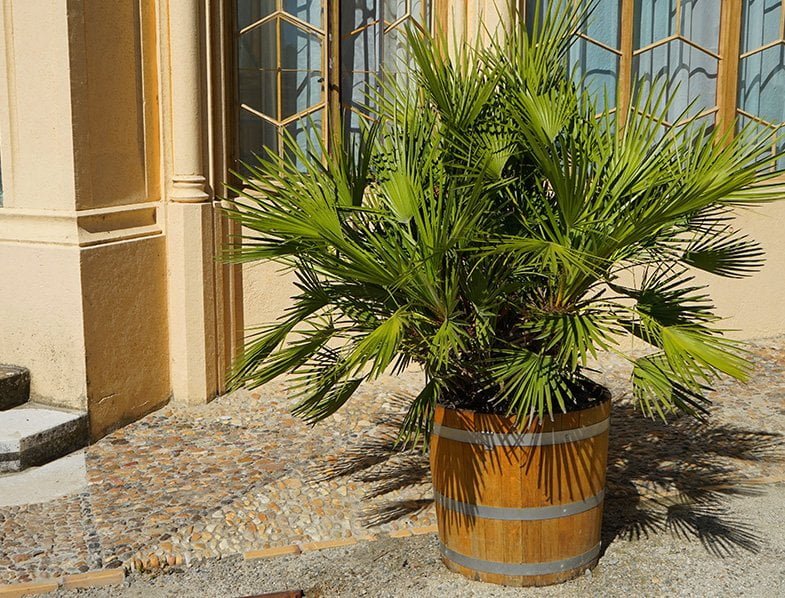
Botanical name: Chamaerops Humilis
These plants need well-draining soil and regular watering. Make sure you have enough space as these plants’ fronds spread wide. However, as these are slow growers, you don’t have to worry about space if you start growing a small plant (of about 1 feet)
| Height | 4 feet |
|---|---|
| Lifespan | Several decades |
| Sunlight | Indirect sunlight to partial shade |
13. Ruffled Fan Palm

Botanical name: Licuala grandis
These plants thrive well in cool temperatures and shades. As they prefer low lighting, watering them can also be reduced. Take special care as sometimes the pleated edges of these ruffled fan plan plants are spine-like.
| Height | 6 feet |
|---|---|
| Lifespan | Several decades |
| Sunlight | Partial to complete shade |
14. Bamboo Palm
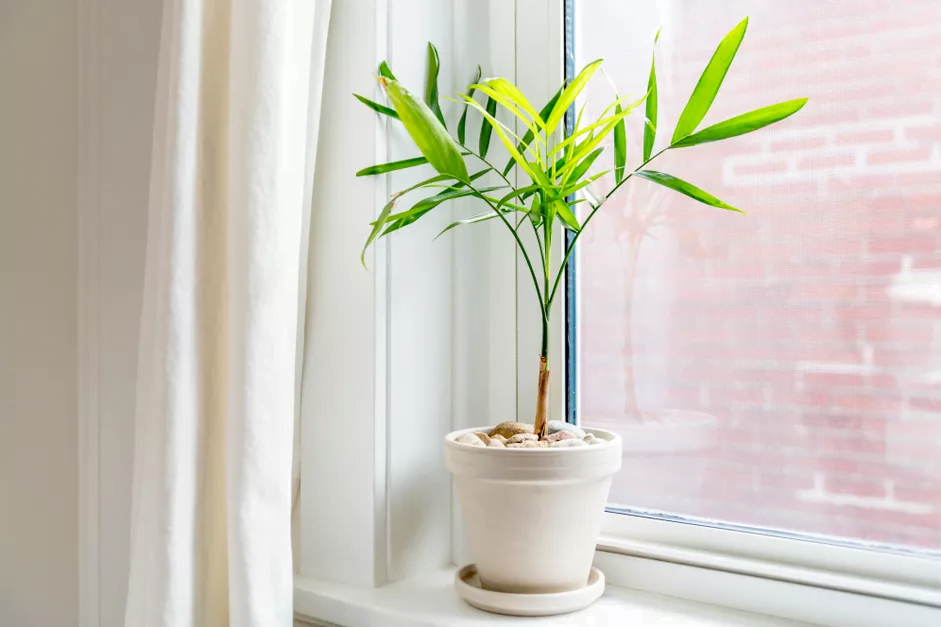
Botanical name: Chamaedorea seifrizii
Even though they are called bamboo, they aren’t bamboo, but still, their growing requirements are very similar to bamboo. These palms thrive in low lighting conditions and constantly need moist soil. Make sure the soil is well-draining to avoid water clogging and root infections.
| Height | 4 – 12 feet |
|---|---|
| Lifespan | Over 100 years |
| Sunlight | Partial shade to shade |
15. Lady Palm

Botanical name: Rhapis excelsa
These palms grow well indoors as they tolerate low lighting, humidity and temperature. Thus making them a perfect choice as a houseplant. Water and feed them regularly during the growing seasons and reduce the caring during the dormant seasons.
| Height | 6 feet |
|---|---|
| Lifespan | Few decades |
| Sunlight | Full to Partial sun |
16. Sentry Palm
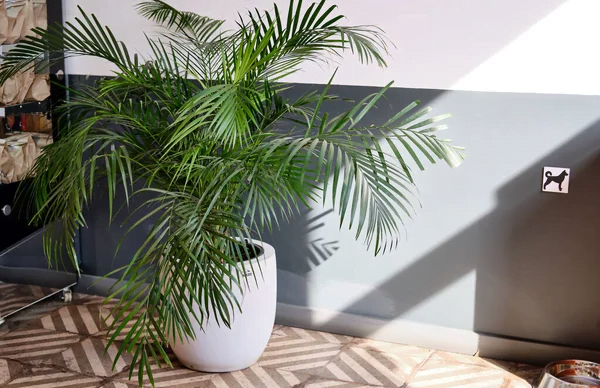
Botanical name: Howea Belmoreana
These are easy to grow indoor plants and are often confused with the kentia palm plants. Even though they share similar visual and growth attributes, they are fond of these plants’ archways more than the other palm trees. These are container plants, and you should be careful about how much water you pour on them, as these containers don’t drain out excess water.
| Height | 10 feet |
|---|---|
| Lifespan | 5 years |
| Sunlight | Indirect sunlight is advisable |
17. Christmas Palm
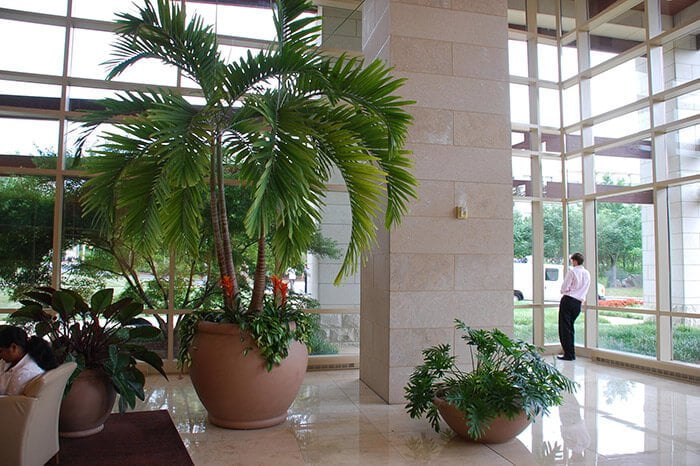
Botanical name: Adonidia merrillii
These plants are grown in containers as a houseplant. Water them only when the topsoil dries. Once they are mature, they become drought resistant and can withstand long intervals without watering. Fertilize the plant once a year to promote better growth.
| Height | More than 20 feet |
|---|---|
| Lifespan | Upto 50 years |
| Sunlight | 4 – 6 hours of full sunlight |
18. Lipstick Palm
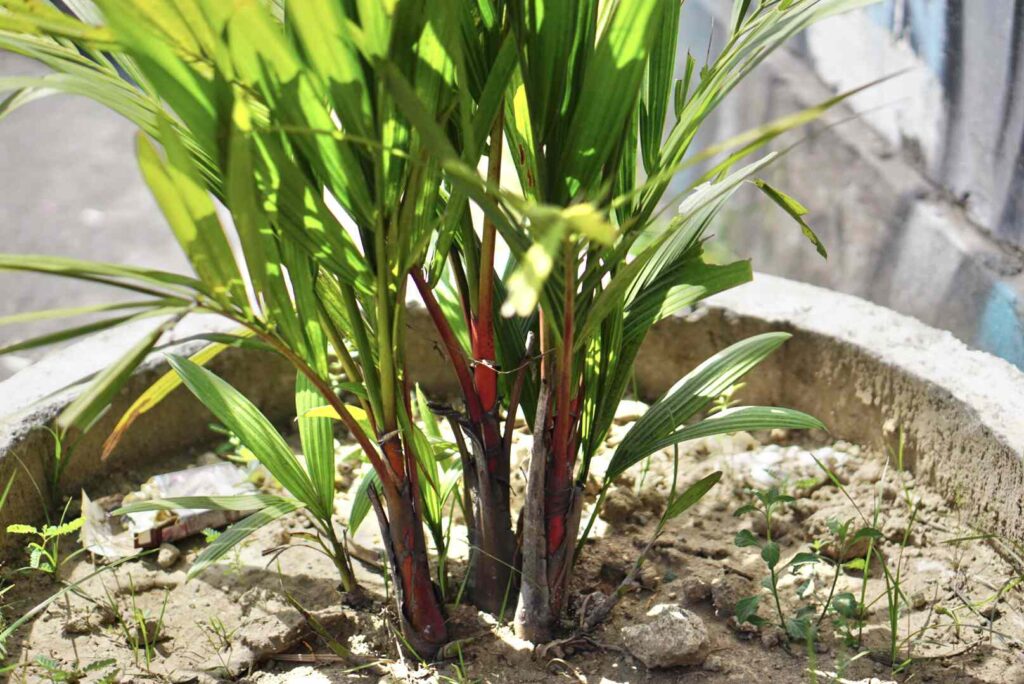
Botanical name: Cyrtostachys Renda
These are moisture-loving trees and prefer to maintain moist soil all the time. Make sure the water level is just moistening and not clogging. Soggy soil is susceptible to root rots and fungal infections.
| Height | More than 10 feet |
|---|---|
| Lifespan | 25 – 30 years |
| Sunlight | Full sun to indirect sun |
19. Red Feather Palm
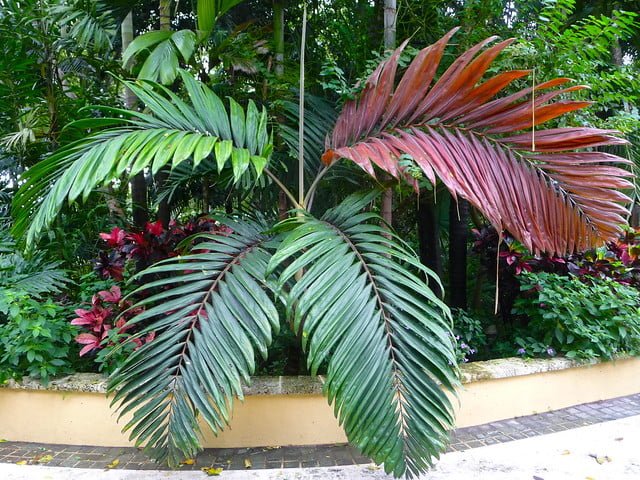
Botanical name: Chambeyronia macrocarpa
These plants will amaze you with their red fronds! They can grow bright scarlet red fronds when they begin to grow and gradually mature into green leaves. By the time one frond matures, you will have a new one already growing. They best suit tropical conditions of warm temperature, high humidity and low lighting.
| Height | 15 – 20 feet |
|---|---|
| Lifespan | Several decades |
| Sunlight | Full sun to partial shade |
20. Diamond Palm

Botanical name: Johannesteijsmannia Altifrons
These are exotic plants with amazing fan-like fronts. Being tropical native plants, they often thrive in warm and humid conditions. Water them moderately as they are grown in containers as a houseplant.
| Height | 10 – 20 feet |
|---|---|
| Lifespan | several years |
| Sunlight | Full sun to partial shade |
How to Care for Indoor Palm Trees
Brace yourself if you generalize caring for tropical indoor palm trees to regular plants. These palm trees are less demanding and relatively easy to grow houseplants. As long as you provide them with ideal conditions, they will accompany you for many years.
We’ll be sharing a few tips to consider while caring for them.
- Sunlight: They thrive best in bright, indirect lighting. Direct sunlight can burn the leaves. Place them near a brightly lit window sill. Don’t forget to pull over the window drapes to diffuse the direct sunlight.
- The parlour palm is an exception among the different types of indoor palm plants, as these plants can easily tolerate shade and low lighting conditions.
- Watering: Palm trees are drought-resistant plants and require minimal water to stay healthy. Watering them once or twice a week. Let the topsoil dry between each watering routine.
- Soil: Palm trees need well-drained soil to avoid fungal infections, especially since they are grown indoors and the chances of overwatering them are high. An ideal soil mixture of loose porous compounds like peat moss, shredded bark, or leaf molds would be perfect. You can also buy palm soil mixture from your nearby nursery.
- Humidity: As these are tropical plants, they prefer high humid conditions. If your home tends to be dry or low moist, try misting the plants or place them over a humidity tray (A tray with water and pebbles)
- Temperature: Ideal temperature range is 25 degrees Celsius to 24 degrees Celsius. To avoid freezing them, refrain from temperatures below 10 degrees Celsius.
- Repotting: Indoor palm trees are mostly slow growers and hardly need repotting. Palms, like cascade trees, like to stay root-bound instead of repotting them.
How to Grow Indoor Palm Trees
You can propagate a palm through seeds and by cutting. However, most palm trees do not support propagation through cutting or air layering methods.
Propagation from seeds
Even though propagating through seeds might take a long time to grow into a full-sized plant, it can be worth the wait. It grows way more successfully than any other method.
- Buy fertile seeds from the nearby nursery or collect them from the flowering trees.
- Now sprout the seeds by placing them in a container filled with moistened soil. Sow them at least 4 inches deep.
- Close and place the container in a warm, humid location. It can take 2 or more months for the seeds to sprout.
- Once the sprouts grow, transfer the container to a bright light zone to promote growth.
- Water the container thoroughly.
- Feed the plant with diluted liquid fertilizers every month.
- After a few months, the saplings will become strong and grow leaves. Now is the best time to transfer them into a larger planter pot.
- It might take several years for the plant to grow to its full size, as most plants don’t even grow more than 12 inches a year.
Propagation from cuttings
Propagation through cuttings is the easiest method to grow a Palm plant. Like other plants, you can’t simply cut and apply root hormone to grow a new plant. You divide the original plant and replant it into two or more pots.
The Palm plants only grow from cuttings that already have established roots and we gently remove these cuttings from the main root to start the propagation process.
It is better to do palm propagation during the growing seasons like spring and summer to avoid stress in the roots. To begin with,
- Select a mature plant that has multiple strong stems.
- Water the plant thoroughly to loosen the soil from the plant.
- Genty dig a trench-like space around the plant and gradually remove them from the soil.
- Wash the roots gently to remove the dirt from them. This also helps in dividing them later.
- Using a sharp knife, cut 2- 3 healthy stems from the root level, making sure you keep as much as roots intact to the plant.
- Plant these cuttings into a new pot with a 2:1 ratio of potting soil and sand.
While selecting a new pot, make sure they have drainage holes at the bottom. This is a major problem in indoor palm plants. These plants do not tolerate moist soil and develop fungal infections and root rots.
- Once plants, immediately water them thoroughly until the excess water seeps out. This allows the plant and its roots to adjust to the new environment.
- Place your plant in a brightly lit, indirect sunlight position to promote faster growth.
Conclusion
Growing your palm tree can be complete bliss. A breezy walk in the park!
It doesn’t matter if you live in a studio apartment or villa; adding these tropical palm plants can elevate your room set up and transport you directly to the tropical condo!
Add a few artefacts and woody furniture, and tada! You are all set to enjoy a completely different world when you step inside your home.
Choose the palm of your choice from our 20 indoor palm plant collections and breathe fresh air for your home and yourself. Literally!!
Related Articles
- Propagating Chinese Elm Bonsai Cuttings And From Seeds
- Best Chinese Elm Bonsai Soil and Fertilizer.
- Troubleshooting Common Problems With Chinese Elm Bonsai
- Buy Chinese Elm Bonsai: How Not to Get Scammed When Purchasing a Chinese Elm Bonsai Tree!
- Chinese Elm Bonsai Pruning And Styling.
- Creating a Chinese Elm Bonsai Forest- Step-By-Step Guide.

